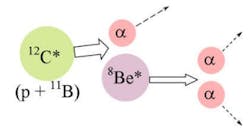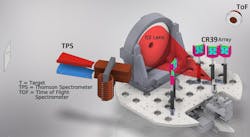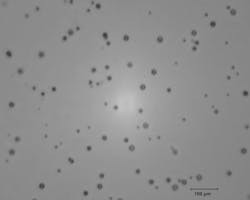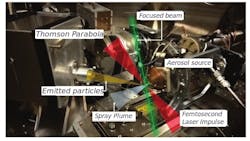During the past two decades, high yields of alpha (α) particles were generated by proton-boron fusion experiments made on plasma irradiated with terawatt and petawatt lasers. The aneutronic proton-boron (p-11B) reaction—in which very little of the energy released is carried by neutrons—appears to be a potential alternative to the deuterium tritium path to net fusion that was pursued with magnetic confinement for more than 50 years.
Related Article
To direct the choice of fuels suitable to achieve p-11B net fusion, research efforts worldwide are now focused on laser boron targets.
Laser proton acceleration: TNSA
The interaction of high-intensity lasers with a sharply bounded, overdense plasma leads to the emission of high-energy protons. Proton boron fusion experiments are prevailingly described in terms of the target normal sheath acceleration (TNSA), which is the best understood and most extensively applied acceleration mechanism. At the expanding bubble, or sheath, which forms near the front target interface over a Debye length (a measure of electrostatic effects within a solution), the ions accelerate because of the space charge separation caused by the fast electrons accelerated by the absorption of the laser radiation.
Electric fields accelerate the protons in a process of indirect energy transfer from the laser to the protons via the electrons. The fields can reach ion energies rising to hundreds of megaelectron volts (MeV). By using targets thinner than the range of the accelerated electrons, a proton emission is observed from the front and the rear sides of the targets. Ions mostly consist of surface contaminants, such as hydrocarbons, which accelerate better because of their high charge-to-mass ratio. Real fusion experiments may involve more than just this one acceleration mechanism.
Double-layer targets
Target ion acceleration research involves blending knowledge from the fields of laser-plasma interaction, photonics, materials science, and nanoengineering.
The laser absorption mechanism in flat solid targets decreases at laser intensities above 1019 W/cm-2. A primary task in project design is to get a higher accelerating field via electron heating control. Research during the past decade shows that coating solid foils with a nanostructured near-critical layer or making a double-layer target (DLT) increases the energy and the total charge of the accelerated ions. Ion beam tuning facilitates fusion experiments significantly.
DLTs are manufactured from a thin metallic substrate, merely a few micrometers (µm) thick, coated with a near-critical layer of nanostructured materials with a thickness up to ~30 µm. Low electron densities are generated by nanoparticles, which provide the beam with a greater attack surface and void spaces covering more than 90% of its volume.
Some target surfaces are perforated with nanometer-sized holes, or are covered with nanowires, which favor a more efficient deposition of laser energy.1 The radiation propagation within the porous nanofoam of these target types leads to a 3- to 4-fold increase in the number of emitted protons.
Recently, researchers at the Polytechnic University of Milan in Italy reported an increase of α particles in experiments using innovative targets of boron foams. The targets were manufactured via femtosecond-pulsed laser deposition techniques.
In an experiment by researchers at the Queens University in Belfast (working with DLTs made in Milan), the highest α particles yield obtained in experiments with the Taranis laser was of 3.3 × 108 α/sr/J—nearly an order of magnitude above the highest yield in literature up to now, which was 5 × 107 α/sr/J.
Until now, most p-11B fusion research used boron-doped silicon or boron nitride solid targets in which the hydrogen contributions to the fusion process were supplied in a low percentage by random contaminants acquired in the manufacturing. Targets combining plastic polymers rich in hydrogen supersede surface contaminants in their function.
Novel borane targets
In 1912, the same year of the Titanic’s tragic voyage across the Atlantic, German chemist Alfred Stock made the first compounds of boron and hydrogen: Boranes. Today, boranes are poised to play a significant role in harnessing p-11B fusion.
Boranes do not occur in nature but are readily synthesized within specialized laboratories from abundantly available natural materials, where multigram- and kilogram-scale production is feasible. Polyhedral clusters of boron atoms are surrounded by a “sheath” of hydrogen atoms and present the largest diversity of any hydride-series of any element (except carbon and its hydrocarbons). For those interested in p-11B fusion, they offer a favorable concentration of hydrogen and boron atoms.
The number of p-11B fusion reactions is assumed to scale with the proton-density in the target, so the p-11B reaction number using borane targets is expected to be significantly higher than boron nitride’s (BN), which is the target most used in past experiments. Prudent estimates, made for the simpler hydride compound ammonia borane (BNH6), anticipate a 10-fold increase of the reaction number.
In 2021, Miroslav Krůs and Michael Londesborough of the Czech Academy of Sciences in Prague proposed fabrication of p-11B fusion targets using octadecaborane (B18H22), a solid boron hydride devoid of any other element that can interfere with the p-11B reaction, such as the atoms of nitrogen in ammonia borane (see Fig. 1). Within the European Consortium Vortex 4 Fusion (www.v4f.eu), Krůs and Londesborough are working toward achieving confinement and laser p-11B fusion using targets based on octadecaborane and other borane materials.
Londesborough’s goal is to gather evidence and experimental proof that the boranes are a leading candidate for p-11B fusion and worthy of a closer examination using the most powerful multiple-laser beam facilities, such as NIF in Livermore, which are capable of the inertial confinement of p-11B-fusion fuels.
For this endeavor, the Institute of Inorganic Chemistry of the Czech Academy of Science synthesized several borane targets, including octadecaborane, and manufactured target discs with a diameter of 13 mm and a thickness of 1.2 mm.
In the first known experiment with binary borane targets, highly compressed discs were irradiated with multiple shots in direct configuration at the PALS laser facility in Prague using an iodine photodissociation laser of 550 J with an intensity of up to 1016 W/cm-2 in 350 ps (FWHM) pulses at a fundamental wavelength of 1315 nm. From these experiments, a highest yield of 1.7 × 109 α/sr per shot was recorded (see Figs. 2 and 3). This result compares well with data from other targets and is, as the team put it: Not bad for a first try!
On request, the Institute can produce novel borane targets in kilogram quantities. They are interested in manufacturing and implementing DLTs, because the more shots they do the more information they get to help them find optimal solutions.
Coulomb explosion acceleration (CEA)
A Coulomb explosion is an acceleration mechanism where the interaction of an ultrashort and intense laser beam with nanometric targets generates high-energy ions that can trigger fusion reactions. If a laser beam depletes a tiny gas cloud of its electrons, the positive ions remaining undergo a strong mutual repulsion because of the respective charge that accelerates them to extremely high energies—and causes a small explosion.
If the cloud or nanoparticles are smaller than the laser wavelength, the top kinetic energy of the explosion depends only on the size and density of the cloud. Nuclear reactions happen within the cloud because of the collisions between the nuclei expelled in the Coulomb explosions. In 1999, Todd Ditmire (then at Lawrence Livermore National Laboratory) and colleagues demonstrated the mechanism to produce deuterium fusion.
In France, a pool of universities and institutes of the National Scientific Research Council (CNRS) pursued the CEA mechanism for p-11B fusion with the ERTIGO project. Their goal is to harness fusion phenomena at microscopic level and in practice by building microreactors that use nanoparticles of boron-doped polymers illuminated by an ultrashort and ultra-intense laser. Effective irradiation requires the nanoparticles be generated within a vacuum or dissolved within a colloid.
The Institute of Light and Matter (ILM) of the University Lyon, the Ecole Supérieure de Chimie Physique Electronique de Lyon-CNRS, and the University of Bordeaux have designed and tested novel target types for p-11B fusion. In their first approach in 2014, they dispersed nanoparticles within a solution and trapped them within microbubbles generated by laser nanocavitation. Irradiated by an intense laser pulse, the trapped nanoparticles would start Coulomb explosions that trigger fusion reactions. The energy supplied by CEA to the center of mass of the nanoparticles or microdroplets with dimensions between 300 and 600 nm matches the maximum cross-section for the activation of the p-11B reaction.
In the laboratory Catalysis, Polymerization, Processes, and Materials (C2P2) of Villeurbanne-Lyon, Elodie Bourgeat-Lamy and Emmanuel Lacote synthesized nanoparticles of latex molecules with suitable dimensions and a rich proton content. Their molecules feature a polyglycerol envelope subsequently doped with boron, and C2P2 validated the concept of producing a nanofuel suitable for p-11B CE fusion.
To monitor the behavior of the particles, Antonin Soleilhac, then a doctoral student at ILM, used a random laser to illuminate latex and gold nanoparticles dissolved within a mixture of water and ethylene glycol. Soleilhac showed that these nanoparticles do not remain trapped inside the bubbles after the nanocavitation, which invalidated the first approach.
In another approach, the Center for Intense Lasers and Applications (CELIA) in Bordeaux carried out tests on the nanoparticle fuels by electrospraying only latex particles dissolved within ethanol into a high vacuum chamber via a heated solenoid valve (see Fig. 4). The droplets were irradiated with their ECLIPSE laser at I > 1019 W/cm-2 over a fs timeframe. Data from the Thomson parabola located inside the chamber reported a peak energy of 0.7 MeV, which Soleilhac interpreted as a mark of protons ejected because of Coulomb explosions happening within the droplets. This result appears to bolster the concept of a pulsed aerosol source containing boron-doped nanoparticles to trigger nuclear reactions at microscopic level using a high-energy and intense laser source.
Addressing future work, Soleilhac points out that a quantitative measure of the number of accelerated particles generated by the Coulomb explosion of the solvent droplets or the nanoparticles will enable a quantitative comparison of the efficacy of aerosol target in respect to the more traditional solid ones.
Applying this method effectively to p-11B fusion poses several challenges that Londesborough is interested in evaluating. Their boranes, at the molecular level, are three-dimensional polyhedral clusters of boron atoms, interconnected via triangular 3-atom, 2-electron bonds, and surrounded by hydrogen atoms that will be stripped of their electrons by the initial barrage from the incident electric field—and lead to an “explosion” of the heavier nuclei due to repulsive Coulombic forces.
Theoretically, if the right balance of laser intensity, pulse duration, and cluster size/composition is achieved, it may be possible to reach the ion energies for fusion. But technical and engineering challenges suggest that a Coulomb explosion alone is unlikely to be sufficient to achieve net energy gain from p-11B fusion. It might be more feasible as part of a multistage fusion process, where Coulomb explosions are used to pre-accelerate ions, followed by other confinement or compression techniques.
While still in its infancy, the quest for an optimal laser fusion fuel is developing quickly to support the worldwide race toward an almost limitless and clean energy.
REFERENCE
- L. Fedeli et al., New J. Phys., 22, 033045 (2020); https://doi.org/10.1088/1367-2630/ab74a4.
About the Author
Vittorio Lippay
Vittorio Lippay has been a member of the Institute of Physics since 2018 and a member of the Institute of Chartered Shipbrokers (London branch) since 2012.




